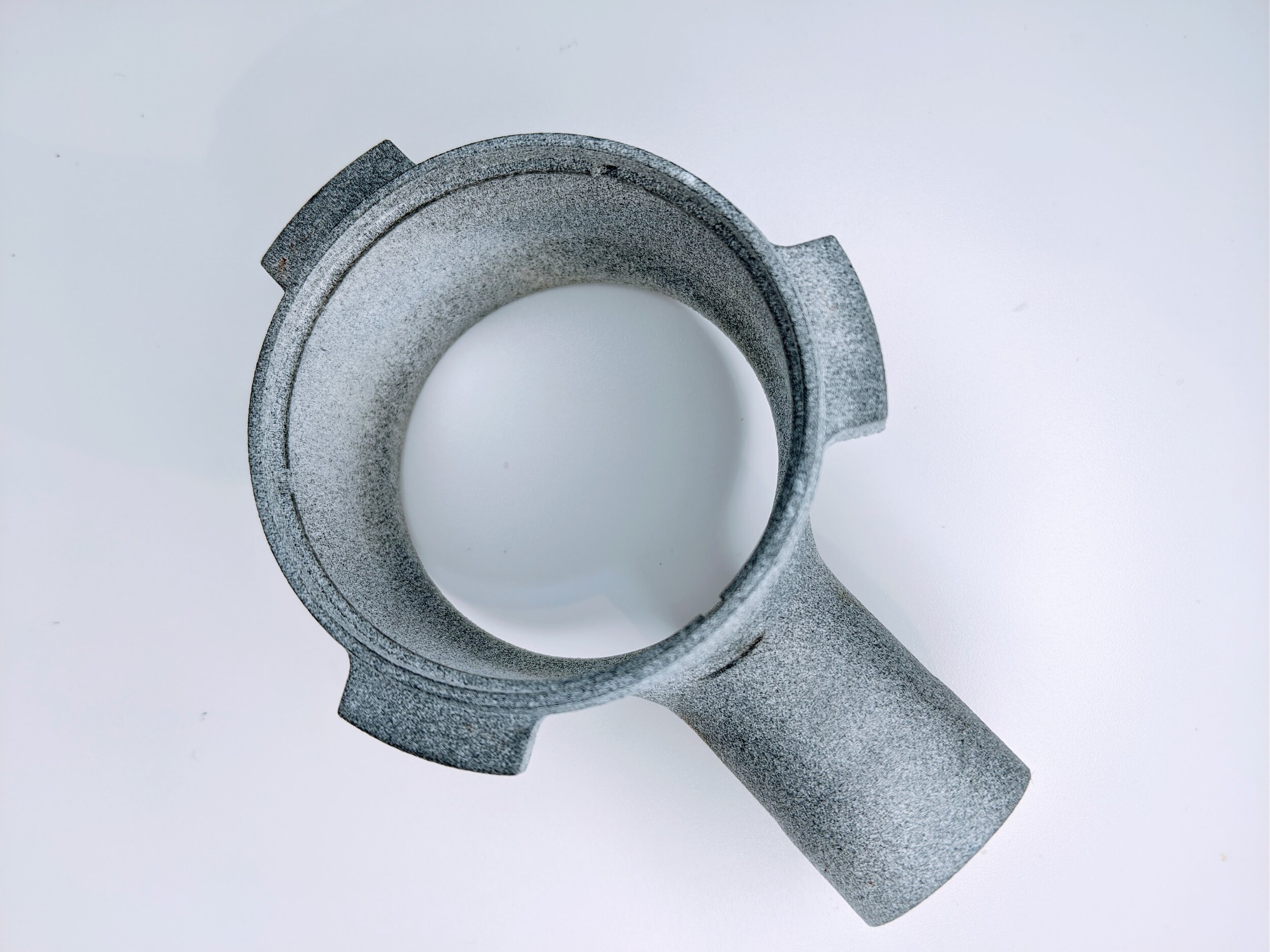A Thermal-Insulating Bottomless Portafilter
Many home espresso machines, like this Breville I had bought a while back, are delivered by default with a double-spout stainless steel portafilter.
While these portafilters achieve their basic function of holding the coffee grinds in place for the espresso machine to dose with water at high temperature and pressure, they are not ideal. There are two main problems:
The bottom of the filter basket is hidden, obscuring details about the coffee extraction that may be valuable to improving the taste of the espresso shot pulled.
The portafilter, being made from stainless steel, has high thermal mass and can pull heat away from the shot.
Original Breville 54 mm Portafilter (Top), This Design (Bottom)
It has been surprisingly difficult to find a portafilter that resolves the two problems above and fits the 54 mm head on the Breville machine I have. Recently, bottomless portafilters in the 54 mm size have become available, and work well to provide a visual on the extraction. However, these are also made from stainless steel and so it must be kept hot prior to pulling the shot to reduce the amount of heat transfer to the portafilter.
Design Approach
To reduce the amount of heat transfer from the grounds to the portafilter, a different material with lower thermal mass is selected for the portafilter holder. This material must still remain stiff under high stress and temperature. For this purpose, Polyamide 12 (PA12, or Nylon 12) was used. This material is available to be 3D printed with low cost and has a heat-deflection rating of 95 C at 1.82 MPa (double the typical 9 bar of pressure from espresso machines). When infused with glass beads (PA12-GB), the heat-deflection goes to 114 C at 1.82 MPa. The thermal mass of PA12 is roughly 1/3 that of stainless steel all else being equal.
Not only does PA12 have lower thermal mass, but also it has a thermal conductivity around 60 times lower than stainless steel. Over the course of a 30 second brew time, this translates to an estimated 10% of heat loss relative to an otherwise identical stainless steel portafilter.
Traditionally, to secure the filter basket to the holder requires the use of a spring clip. Due to the stiffness of stainless steel, the spring clip is required to “snap” the basket into place. However, when made with thermoplastics like PA12, it allows for the clip to be designed in since the holder itself has some flex.
Testing
As with any design, a few iterations were required to get the fit and functionality to the desired level. Early versions were printed in different materials, but were found to be too flexible/soft to be reliable in practical testing. The first version required a steel spring clip and had a relatively small bottom cut-out. As the design was refined, the bottom cut-out was enlarged while reinforcing the connection from the basket holder to the handle.
Development prototypes, from the original version (Top-Left), to the latest design (Bottom-Right).
Taking the first prototypes to the espresso machine was initially a harrowing experience. Without a definitive idea of how the part will respond to the heat and pressure applied, care had to be taken to avoid scalding from the hot water. However, after arriving at a working version and a few months of practical testing (approximately once-a-day) without issue, I have much more confidence in the integrity of the part. Most of the testing was done with the standard PA12 (i.e. not PA12-GB) basket holder. PA12-GB is expected to have more long-term durability due to higher heat-deflection rating.
A measurement of the actual change in brew temperature over time with the new portafilter is needed before we can definitively determine an improvement was made. This requires instrumentation (i.e. thermocouple) that I don’t have access to at this time. However, I can say that the outside of the PA12 portafilter holder remained cool-to-touch throughout the brew time while the stainless steel eventually became too hot. This is a good sign that less energy was lost from heating up the portafilter.
Build Instructions
The materials and assembly instructions are found below in gallery format.
TO PURCHASE FOR YOUR OWN USE (self-assemble): Click on the images for more details and purchasing options. In the expanded view, the details are available on mouse-over (desktop) or using dot on the bottom right corner (mobile).



















